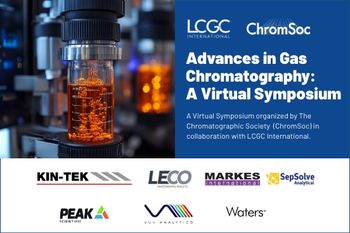
E-Separation Solutions
- E-Separation Solutions-07-20-2010
- Volume 0
- Issue 0
Food Analysis/Quality
Participants in this Technology Forum are Deanna Hurum of Dionex Corporation, Sue Steinike of Shimadzu Scientific Instruments, and Gerry Broski and Eric Phillips of Thermo Fisher Scientific.
The analysis of the world’s food supply is one of the most important tasks in analytical chemistry. Participants in this Technology Forum are Deanna Hurum of Dionex Corporation, Sue Steinike of Shimadzu Scientific Instruments, and Gerry Broski and Eric Phillips of Thermo Fisher Scientific.
What new challenges are facing food and beverage analysts?
Hurum: Food and beverage analysts are faced with constant changes in additives used for food adulteration, new products with few reference standards, and the need to verify fortified food claims in a complex matrix. Food adulteration is not a new challenge; however the variety of adulterants and the manipulation of current methods to obscure the adulteration require constant method development with samples that are inherently complex.
Steinike:Sample prep is always a challenge, but I think "new" challenges have to do with food safety and testing for more/different contaminants like pesticide residues and bacteria/mycotoxins. Another issue is how to accurately determine bioavailability of different vitamins and nutrients from the raw ingredients to the finished product.
Broski and Phillips:Challenges are coming in the form of emerging unforeseen risks or threats to safety and health caused by a variety of factors. Changes in our environment and in our attitudes towards the role of food in our overall health will provide a constant stream of new challenges and opportunities for analysts. The food chain is a dynamic system manipulated by man and nature in which each change creates a reaction or consequence. Environmental changes such as volcanoes and climate change will affect the growth of microorganisms and the related toxins. We are all aware of the obvious factors which can pose a threat to the safety of the food supply including, excessive application of a particular pesticide or the chemical nature of the pesticide itself. Another hazard is excessive or unapproved use of an antibiotic. These are fairly straightforward, but there are more complicated scenarios evolving as we see great man-made changes unfolding, such as the oil spill and the potential for food contamination; as we apply nanoparticles to food and packaging; as we cope with scarcity of ingredients and of course the threats of adulteration and contamination both deliberate and accidental. Challenges specific to the mechanics of lab analysis include automation of sample preparation and greater implementation of LIMS data systems to automate reporting and sample tracking. These needs must be addressed by each lab to enable the analyst to focus on the science of the analysis.
Which analytical techniques are the most important for food chemists?
Hurum:Separation techniques are invaluable for food chemists. The ability to resolve multiple components specifically with a wide variety of selectivities is critical. For these reasons methods that complement each other, such as high performance liquid chromatography (HPLC) and ion chromatography are important. Food additives or existing components that are difficult to detect by one method can become easily quantified by using another. Mass spectrometry (MS) is useful for method development and investigation of food adulteration, providing another check to ensure that the method is resolving all the necessary components.
Steinike:I think this depends on the analyte and the type of process being performed. For testing incoming raw materials the analyst may need to use gas chromatography (GC) and GC–MS (pesticide residues) or Fourier-transform infrared (FT-IR) (homogeneity) or atomic absorption (AA)/inductively coupled plasma (ICP) (presence of metals). For finished product testing like checking a formulation, then GC or LC would probably be used. For checking package integrity, UV, FT-IR, or GC–MS could be used. Other chemists will be examining the physical properties of various foods — viscosity, stretchiness, and crunchiness, for example — and a texture analyzer would be used for these purposes. For moisture content (like for dehydrated fruits and vegetables), a moisture balance.
Broski and Phillips:GC–MS, LC–MS, and microbiological testing are most important and most common depending on the matrix and the reason for testing. Instrumented test methods are constantly improving and manufacturers are responding to the need for screening tools such as a high-resolution bench-top mass spectrometer that can be used for high throughput screening for the LC–MS analysis. Manufacturers also respond with new and innovative techniques using traditional instrumentation. The sensitivity of GC–MS (specifically triple-quadrupole GC–MS) has allowed extraction techniques to evolve from complete cleanup to rapidly preparing samples for analysis. The capability of the modern instrument allows them to provide data in situations that would have been impossible 5–10 years ago. This can be seen in applications using no sample extraction analyzing pesticides in tea by driving the compounds into the headspace and using solid-phase microextraction (SPME) for the compound collection. As demands for testing increase, the drive will be for efficient screening tools and methods. On the micro side, there is also great demand for faster analysis and automated techniques including lab on a chip are getting closer to popular acceptance.
Which food types present the greatest challenge for food analysts in terms of sample preparation and analysis?
Hurum:Food sample preparation and analysis is inherently challenging. Foods are a complex mixture of proteins, fats, and carbohydrates that can make preparation particularly difficult. Extraction of native or added analytes from this mixture can be time consuming and recoveries are highly variable. Fortified dairy products can be particularly challenging from this perspective as they contain homogenized fats and both high protein and carbohydrate contents. Effectively extracting analytes from this type of complex hydrophilic/hydrophobic mixture is difficult.
Steinike:This may again depend on the analysis technique: for LC, samples like salad dressing or pudding may require several extraction steps to get the analytes to be soluble in HPLC mobile phases. Samples like cake, cookies, cereal, or crackers would also require dissolution and filtration for LC, GC, AA, and ICP analysis.
Broski and Phillips:Fatty or starchy food can be the most difficult to deal with as the extraction techniques are quite involved to obtain the analyte of interest.
Have official methods for food analysis kept pace with food industry requirements?
Hurum:It is very difficult for official methods to keep pace with the constant changes in the food industry. Food adulterants are chosen to exploit weaknesses in the official methods, and keeping ahead of changes in legitimate food additives and improper food adulterants is challenging.
Steinike:This is a difficult one to answer as requirements change so frequently, often in response to new regulations or incidents involving contaminations. The USP and AOAC continue to publish new methods but whether they are keeping pace with what the industry wants, or needs (with respect to new testing requirements), is difficult to determine.
Broski and Phillips:To a certain extent official methods have provided the basis for many of the methods in popular use. Recognizing the demand for new and different methods, official methods organizations are reaching out the scientific community to help identify needs and requirements to prioritize their method development schedule.
Can you speculate about future trends that might test the current limitations of food analysis?
Hurum:Nutraceutical and functional food products designed to provide health benefits will be more closely regulated with both minimum and maximum amounts of the additives allowed. This allowed window will require analytical methods with well defined upper and lower detection limits and good reproducibility. Food adulteration has always tested limitations in food analysis and will continue to do so.
Steinike:One trend is the inclusion of natural/herbal products in many different foods and beverages and not a lot is known about many of those compounds: active ingredient, number of compounds present, what is an appropriate "dose" or RDA of these substances. The FDA is stepping up the regulation of these substances and companies will have to do a lot of research to ensure they are safe before being able to use them in their products.
Broski and Phillips:It is apparent that there is increasing demand for food safety testing and to keep up with the sheer volume methods of analysis will have to be efficient, cost effective, and reliable. Increased testing is good and bad — good in the sense that the general public is much more informed and concerned about the food they eat. Nutrition, allergy concerns, obesity, safety, quality, are becoming more and more visible to the consumer meaning we want to take better care of ourselves. There is, however, a limit to the amount of testing that you can do, and food is just like any other product, in the sense that you cannot test your way to quality. Quality and safety require that proactive measures are taken in the production of food that mitigate the risks and lessen the dependence on testing.
If you are interested in participating in any upcoming Technology Forums please contact Group Technical Editor
Articles in this issue
Newsletter
Join the global community of analytical scientists who trust LCGC for insights on the latest techniques, trends, and expert solutions in chromatography.




